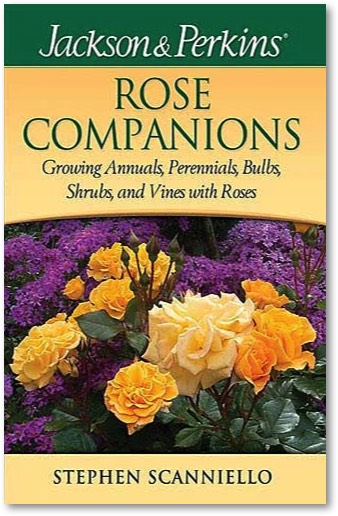
Musings » Jackson and Perkins Rose Companion: growing annuals, perennials, shrubs and vines with roses


Nashville, Tennessee
Cool Springs Press 2004
There is no doubt about it. We treat roses as if they were goddesses with their own special religion. As noted in this column on previous occasions, the rose was known and illustrated in pre-history. The Romans considered them to be more precious than almost anything else. The blossoms were showered on honored guests at banquets. Whole cities devoted themselves to cultivating this plant to feed the insatiable appetite for blossoms and petals in the principal city of the republic.
In this book Stephen Scanniello tells us of his maturation as a rose maniac. He had loved to watch his grandfather take care of favorite roses as a child. As an adult he bowed down to the goddess and grew the plants in clusters, unsullied by any of the other, commoner sorts of flower. The classic rose garden of parks and great gardens were all like this. Purity was the watchword. If any other flower crept in it was by chance and most likely would be ruthlessly suppressed. That was while he was the curator of a public rose garden.
At some point he had an epiphany and realized that roses could be part of the composition of a garden and should be highlighted against a background of other plants. There is a bleakness about a rose bed with its regimented standards standing to attention in strict rows or blocks. The blossoms are lovely, the foliage has its own qualities but the rest of the plant does not stand up to the scrutiny demanded by this degree of exposure. In late fall and winter, when foliage and flowers are gone, then the remaining dull sticks are a very sorry sight. Blackspot, powdery mildew and other diseases also detract from the charm.
By using roses in a group setting, many of these disadvantages are disguised. For example, in considering what to do about winter, box or yew interplanted through the bed gives color and structure, drawing the eye away from the collective blemishes.
Bringing the rose down off its pedestal partly reflects the fact that modern roses are a lot tougher than the ones Mr Scanniello’s grandfather coddled so carefully. We can be more matter of fact about them once they are resistant to disease, hardier than ever and generally need much less care than ever before.
There are rose breeders in the upper mid-West who run “boot camps” for roses. They plant selected new hybrids out in open fields and let them get on with it for five years: no irrigation, no fertilizer, no disease control, just the effects of nature and the weather. At the end of that time, the ones that are still flourishing are then re-evaluated.
In Germany Wilhelm Kordes IV, great grandson of the original Kordes, is doing something of the same sort. Once a rose has shown its mettle in this way the ordinary person who just wants a couple of rosebushes to highlight his border can be certain that they will perform.
Stephen Scanniello divides his topic into five chapters: the garden qualities of roses, knowing the location, designing the garden, choosing and growing roses and their companions and finally a directory of companions. The keys to successful pairing of roses and companion planting lie in the choice of color, foliage, habit, and seasonal variation.
Providing one allows for the cultural requirements of the companion and makes sure they are in bloom at the proper time, there are really no rules. The gardener has an almost endless supply of flowers with which to augment his rose border, or by contrast, put rose bushes in the existing border to the best advantage.
There are very well chosen anecdotes to illustrate his point. In one garden a red ‘Veterans’s Honor’ standard had grown a bit too tall. To take advantage of the shade this created at the base of the standard, the owner planted red impatiens in the same hue.
The author provides very clear instructions all the way through. I particularly liked the directory which runs for the last 50 pages. He supplies a great deal of information in an informal and comfortable style. The illustrations are lavish and effective. This is a very useful book.

